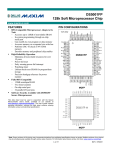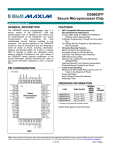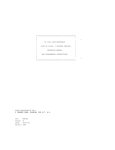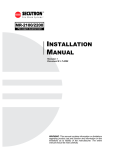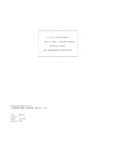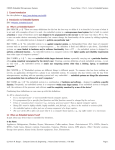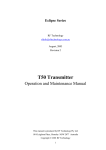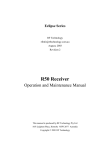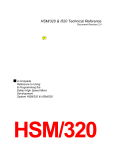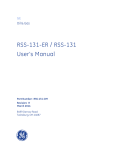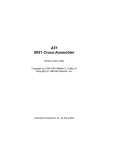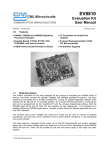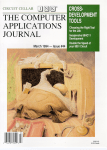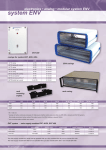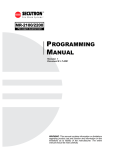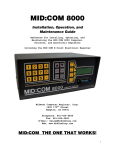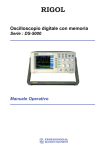Download DPB2 Technical Reference
Transcript
DPB2 Technical Reference Document Revision 1.3 A Complete Reference to Using & Programming the Universal Dallas Development System DPB2 DPB2 LIMITED WARRANTY The information in this manual is subject to change without notice and does not represent a commitment on the part of Systronix, Inc. Systronix, Inc. makes no warranty, express or implied, for the use or misuse of its products, which are provided with the understanding that you, the user, will determine fitness for a particular application. Systronix assumes no responsibility for any errors which may appear in this manual. No part of this manual may be reproduced or transmitted in any form or by any means, electronic or mechanical, including photocopying and recording, for any purpose other than the purchaser's personal use without the written permission of Systronix, Inc. Systronix reserves the right to revise this documentation and the software and hardware described herein or make any changes to the specifications of the product described herein at any time without obligation to notify any person of such revision or change. TRADEMARKS Systronix is a registered trademark of Systronix Inc, INTEL and Intel are registered trademarks of Intel Corporation, Microsoft and MS-DOS are registered trademarks of Microsoft Corporation, OrCAD is a trademark of OrCAD Systems Corporation. Systronix®, Inc. 555 South 300 East #21 Salt Lake City, UT 84111 TEL: 801-534-1017 FAX: 801-534-1019 Internet: www.systronix.com email: [email protected] Copyright © 1993-1996 by Systronix®, Inc. All rights reserved. Revision 1.3 - October 31, 1996 A WORD FROM THE AUTHOR This manual was created using WordPerfect 7.0. Schematics were created with OrCAD SDT III. Postscript output was obtained from an Apple LaserWriter IINT. Graphics were created with Generic CADD. - Bruce Boyes, Systronix, Inc. DPB2 Technical Reference Systronix, Inc. Complete Solutions for Rapid Development of Embedded Control Systems Document Revisions 1.3 Changed programming instructions to recommend not using PR command. Cleaned up some typos and error in reference to relay outputs. Added references to internet site. Removed A51 assembler documentation - it is now a separate document. Table of Contents DPB2 . . . . . . . . . . . . . . . . . . . . . . . . . . . . . . . . . . . . . . . . . . . . . . . . . . . . . . . . . . . . . . . . . . . . 1 I/O Driver Files . . . . . . . . . . . . . . . . . . . . . . . . . . . . . . . . . . . . . . . . . . . . . . . . . . . . . . . . . . 1 Systronix Web Site & Forum . . . . . . . . . . . . . . . . . . . . . . . . . . . . . . . . . . . . . . . . . . . . . . . 1 Getting Technical Support . . . . . . . . . . . . . . . . . . . . . . . . . . . . . . . . . . . . . . . . . . . . . . . . . . 1 INSTALL BCI51 . . . . . . . . . . . . . . . . . . . . . . . . . . . . . . . . . . . . . . . . . . . . . . . . . . . . . . . . 2 DPB2 Example Program Files . . . . . . . . . . . . . . . . . . . . . . . . . . . . . . . . . . . . . . . . . . . 2 PROCESSOR INSTALLATION . . . . . . . . . . . . . . . . . . . . . . . . . . . . . . . . . . . . . . . . . . . . 2 JP3 2250/2252 Jumper . . . . . . . . . . . . . . . . . . . . . . . . . . . . . . . . . . . . . . . . . . . . . . . . . 2 DALLAS SERIAL LOADERS: IMPORTANT NOTES! . . . . . . . . . . . . . . . . . . . . . . . . . . 3 What are the Dallas Serial Loaders? . . . . . . . . . . . . . . . . . . . . . . . . . . . . . . . . . . . . . . . 3 Loader Script File Tips & Example . . . . . . . . . . . . . . . . . . . . . . . . . . . . . . . . . . . . . . . . 4 KIT5K vs K2 . . . . . . . . . . . . . . . . . . . . . . . . . . . . . . . . . . . . . . . . . . . . . . . . . . . . . . . . 5 Dallas .CFG Files . . . . . . . . . . . . . . . . . . . . . . . . . . . . . . . . . . . . . . . . . . . . . . . . . . . . . 5 PROGRAM vs LOAD . . . . . . . . . . . . . . . . . . . . . . . . . . . . . . . . . . . . . . . . . . . . . . . . . 6 QUICK START . . . . . . . . . . . . . . . . . . . . . . . . . . . . . . . . . . . . . . . . . . . . . . . . . . . . . . . . . 6 File Extensions .SRL and .INC . . . . . . . . . . . . . . . . . . . . . . . . . . . . . . . . . . . . . . . . . . . 6 First Program . . . . . . . . . . . . . . . . . . . . . . . . . . . . . . . . . . . . . . . . . . . . . . . . . . . . . . . . 6 DPB2 I/O MAP . . . . . . . . . . . . . . . . . . . . . . . . . . . . . . . . . . . . . . . . . . . . . . . . . . . . . . . . . 9 Available Processor I/O Pins . . . . . . . . . . . . . . . . . . . . . . . . . . . . . . . . . . . . . . . . . . . . . 9 Address Demultiplexer . . . . . . . . . . . . . . . . . . . . . . . . . . . . . . . . . . . . . . . . . . . . . . . . . 9 EXTERNAL MEMORY OR PERIPHERAL DEVICES . . . . . . . . . . . . . . . . . . . . . . . . . . . 9 Recommended Peripheral Addressing . . . . . . . . . . . . . . . . . . . . . . . . . . . . . . . . . . . . . 10 Protecting Processor Pins from Static or Under-voltage . . . . . . . . . . . . . . . . . . . . . . . 10 POWER SUPPLY . . . . . . . . . . . . . . . . . . . . . . . . . . . . . . . . . . . . . . . . . . . . . . . . . . . . . . . 10 LCD DISPLAYS . . . . . . . . . . . . . . . . . . . . . . . . . . . . . . . . . . . . . . . . . . . . . . . . . . . . . . . 11 LCD Connector Pinout . . . . . . . . . . . . . . . . . . . . . . . . . . . . . . . . . . . . . . . . . . . . . . . . 12 LED Backlights . . . . . . . . . . . . . . . . . . . . . . . . . . . . . . . . . . . . . . . . . . . . . . . . . . . . . 12 20x4 LCD with LED Backlight . . . . . . . . . . . . . . . . . . . . . . . . . . . . . . . . . . . . . . . . . . 13 16x2 LCD with LED Backlight . . . . . . . . . . . . . . . . . . . . . . . . . . . . . . . . . . . . . . . . . . 13 LCD Drivers . . . . . . . . . . . . . . . . . . . . . . . . . . . . . . . . . . . . . . . . . . . . . . . . . . . . . . . . 13 LCD Enclosures . . . . . . . . . . . . . . . . . . . . . . . . . . . . . . . . . . . . . . . . . . . . . . . . . . . . . 13 KEYPAD USE . . . . . . . . . . . . . . . . . . . . . . . . . . . . . . . . . . . . . . . . . . . . . . . . . . . . . . . . . 13 KEYPAD LEGENDS . . . . . . . . . . . . . . . . . . . . . . . . . . . . . . . . . . . . . . . . . . . . . . . . . . . . 16 DIGITAL INPUTS . . . . . . . . . . . . . . . . . . . . . . . . . . . . . . . . . . . . . . . . . . . . . . . . . . . . . . 17 External Input Jumper Blocks JP18 and JP19 . . . . . . . . . . . . . . . . . . . . . . . . . . . . . . . 17 RELAY DRIVER OUTPUTS . . . . . . . . . . . . . . . . . . . . . . . . . . . . . . . . . . . . . . . . . . . . . . 18 BUZZER . . . . . . . . . . . . . . . . . . . . . . . . . . . . . . . . . . . . . . . . . . . . . . . . . . . . . . . . . . . . . 18 ANALOG to DIGITAL CONVERTER . . . . . . . . . . . . . . . . . . . . . . . . . . . . . . . . . . . . . . . 19 ADC Throughput . . . . . . . . . . . . . . . . . . . . . . . . . . . . . . . . . . . . . . . . . . . . . . . . . . . . 19 JP15 I/O CONNECTOR . . . . . . . . . . . . . . . . . . . . . . . . . . . . . . . . . . . . . . . . . . . . . . . . . . 20 APPLICATION EXAMPLES . . . . . . . . . . . . . . . . . . . . . . . . . . . . . . . . . . . . . . . . . . . . . . 21 DPB2 I/O DRIVERS . . . . . . . . . . . . . . . . . . . . . . . . . . . . . . . . . . . . . . . . . . . . . . . . . . . . 21 LOADING PROGRAMS . . . . . . . . . . . . . . . . . . . . . . . . . . . . . . . . . . . . . . . . . . . . . . . . . 21 DEBUGGING DPB2 SOFTWARE and HARDWARE . . . . . . . . . . . . . . . . . . . . . . . . . . . 23 Internet FAQ . . . . . . . . . . . . . . . . . . . . . . . . . . . . . . . . . . . . . . . . . . . . . . . . . . . . . . . . 23 Start Simple . . . . . . . . . . . . . . . . . . . . . . . . . . . . . . . . . . . . . . . . . . . . . . . . . . . . . . . . 23 Exception Handling . . . . . . . . . . . . . . . . . . . . . . . . . . . . . . . . . . . . . . . . . . . . . . . . . . 23 Quick Diagnosis Table . . . . . . . . . . . . . . . . . . . . . . . . . . . . . . . . . . . . . . . . . . . . . . . . 23 SCHEMATICS and MECHANICAL DRAWINGS . . . . . . . . . . . . . . . . . . . . . . . . . . . . . 25 Schematics . . . . . . . . . . . . . . . . . . . . . . . . . . . . . . . . . . . . . . . . . . . . . . . . . . . . . . . . . 27 Enclosure Drawings . . . . . . . . . . . . . . . . . . . . . . . . . . . . . . . . . . . . . . . . . . . . . . . . . . 37 Sample Keypad Legends . . . . . . . . . . . . . . . . . . . . . . . . . . . . . . . . . . . . . . . . . . . . . . . 41 A51 ASSEMBLER . . . . . . . . . . . . . . . . . . . . . . . . . . . . . . . . . . . . . . . . . . . . . . . . . . . . . . . . 43 i ii DPB2 Rapid Development System Systronix® Universal Dallas Development Board Rapid application prototyping and development for all the Dallas 8051compatible soft microcontoller families with the new DPB2 from Systronix. Now a single development board supports all Dallas DIP and SIPstick 8051-compatible soft microcontrollers. Add our real-time BASIC compiler for the easiest embedded control ever! Experiment with the entire Dallas 8051-compatible processor family on one convenient board which accepts any Dallas DIP or SIPstick processor. Change to a different processor in seconds. • 5-13VDC power input, on-board voltage regulator DPB2 is a versatile single board computer with LCD and keypad interfaces, serial I/O, rugged digital inputs and outputs, analog to digital conversion, voltage regulator, and an ample prototyping area. • 19.2Kbaud RS232 I/O port and 19.2Kbaud RS232 serial printer port Add our easy-to-use BCI51PRO BASIC compiler and you'll have your system completed in a flash! • Four rugged digital inputs • All processor ports brought out to labelled headers • 8x2 header easily connects I/O and power to external equipment • 4 by 4 keypad encoder/debouncer • Parallel 4- or 8- bit LCD interface • Four 350 mA 35V open collector digital outputs • 8-bit ADC, adjustable input range • Generous prototyping area for DIP, PGA, ZIP and SIMM packages • Standard 100mm by 160mm size What are Dallas Soft Microcontrollers? DPB2 DETAILED DESCRIPTION Dallas soft microcontrollers are high performance, low power, CMOS systems that contain the equivalent of a single board computer in one compact SIP or DIP package. An embedded lithium cell preserves the contents of the on-board code and data memory (up to 64 Kbytes of each) for 10 years with no external power. A 'T 'suffix (DS2250T, DS5000T, etc) indicates a real time clock and calendar chip which keeps time for 10 power-off years. Because system code and data memory is on board, I/O ports need not be used for an address and data bus. Other unique features include an on-board serial loader, watchdog timer, power-fail interrupt, and flexible power-up and restart options. Contact Dallas Semiconductor at 972-3714000 or www.dalsemi.com, or follow the links from www.systronix.com. What is the Dallas Serial Loader? The Dallas processors have built-in ROM support for serial loading of HEX files. The Dallas processors’ serial loader is automatically activated by DPB2’s special reset/load hardware. Using the included software, you can reprogram a Dallas Soft Microcontroller in seconds over its serial port without changing jumpers or unplugging and erasing EPROMs. You can encrypt and lock your program or data to prevent unauthorized tampering - in fact, many bank teller machines are based on the DS2252 Secure Microcontroller. What is the BCI51-PRO BASIC Compiler? ...the easiest and quickest way to program an 8051! QuickBASIC users will feel right at home. BCI51-PRO allows you to program all 8051 and 8052 family parts, and is the only high level language with specific keyword support for the Dallas processors. BCI51-PRO includes excellent documentation and support, including a complete suite of DPB2 I/O drivers. Why struggle with C or assembly? With BCI51 you can write your application in days instead of weeks. What if I Want a Custom DPB2? We can quickly customize DPB2 hardware or firmware to meet your needs and deliver a working prototype in two to four weeks. How do I order? Please refer to our Product Matrix & Price List and Order Form for detailed option and ordering information. All systems include: · DPB2 user manual · Dallas Soft Microcontroller Data Book · DBP2/BCI51 application notes · Wall cube power supply, 120 VAC input, 6 VDC 300 mA output · Systronix A51 assembler · Serial loader software · BCI51-PRO and assembly language source code for reading the keypad, writing to the LCD, reading the ADC, reading digital inputs, and driving the digital outputs Stocked Options: · 4 by 4 splashproof keypad and cable with connectors · LCDs: 4 by 20 or 16x2 supertwist with LED backlight · Rugged, attractive enclosures with keypad, 20x4 LCD, and a variety of end panels with various I/O connections. · Dallas microcontrollers in 40 DIP and 40 or 72 SIMM packages · Compact buzzers and tone generators · BCI51-PRO BASIC compiler Processor sockets 72 SIMM for DS2251, 40 SIMM for DS2250 and 2252, 40 DIP for DS5000. Crystal, serial and other I/O ports are common to all processor sockets. Power Unregulated 6-13 VDC or 5 VDC regulated. 5.5x2.5 mm unregulated input power jack. Regulator input and ouput are also available at the 8x2 system I/O header. The regulator is reverse-polarity, short-circuit and overtemperature protected. DPB2 typically consumes 75-100 mA, depending on processor and memory options. Serial I/O RS232 serial I/O (DB9M) and serial printer output (5x2 header). Keypad Encoder A 4x4 keypad encoder interrupts the processor when debounced keypad data is ready. A patch area (JP17) is provided to remap keypad row and column order. Keypad connection is an 8x1 header. LCD Interface 16x1 header supports intelligent 4- or 8bit parallel-interface LCDs. LED backlight current limiting resistor and LCD contrast adjustment. High Current Outputs Four 350 mA, 35 V opencollector relay drivers with snubbing diodes. Connection via the 8x2 system I/O header. Buffered Digital Inputs Four rugged inputs withstand ±30 volts and include internal 3 Kohm pulldowns. A jumper block connects these four inputs to the processor timer and interrupt pins, or leaves them unconnected. Connection is via the 8x2 system I/O header. ADC An 8-bit analog to digital converter with a variable 2.5 to 5.0 reference voltage and an adjustable input attenuator. At the 5.0 volt reference setting, resolution is 19.6 mV per bit. ADC input connection via 2-pin header or the 8x2 system I/O header. Prototype Area 319 plated through holes on .100" centers in an 11 by 29 grid for any size DIP or PGA, plus two rows of 29 pads offset by .050" to accommodate ZIP or SIMM sockets. Heavy power and ground busses on .025" headers. Every pad is surrounded by ground plane perfect for low-noise analog circuitry. Expansion An 8x2 system I/O header provides an easy way to cable digital and analog I/O and power from/to external equipment. All processor ports and I/O pins are brought out to labeled .025" square headers on .100" centers. An HCT573 demultiplexes the address and data bus for external memory access. Easy Program Loading Serial program loading can be initiated by on-card pushbuttons or the RS232 DTR line. Serial loader software is included. A bicolor LED glows green when running and red when loading. Size Standard 100x160 mm single Eurocard size, hundreds of enclosures available (some stocked by Systronix) including RF shielded, NEMA rated, etc. Environmental Commercial temperature range of 0 to 70 deg C. Support & Warranty Unlimited friendly technical support. One year warranty against defects. Systronix Inc. ® 555 South 300 East #21, Salt Lake City, Utah, USA 84111 Tel:(801)-534-1017 Fax:(801)-534-1019 www.systronix.com rev 1996 Oct 14 bab DPB2 Technical Reference - October 31, 1996 - Systronix®, Inc. DPB2 Thank you for purchasing the Universal Dallas Development System DPB2! The current revision of the DPB2 circuit board is “E”. DPB2 (Dallas Proto Board 2) is the first system specifically designed to support the entire Dallas Secure Microcontroller family. The unique arrangement of three sockets enables you to use all three Dallas package types with one board, and change between them in seconds. DPB2 with BCI51 was voted one of the 100 Hot Products by readers of EDN Magazine. DPB2 is ideal for experimentation and development as well as incorporation in a finished product. DPB2 is designed to work with any of the Dallas Soft Microcontrollers. In 1996, Dallas began referring to these as the Secure Microcontrollers. Systronix has other development boards designed for the Dallas High Speed Microcontrollers. DPB2s are in use world-wide in development projects as diverse as DNA replicators, liquid dispensing systems, vending machines, and electric vehicle motor controllers. I/O Driver Files Example programs and I/O "include" files for DPB2 revision E have the letter E in their name, such as ADC_E.INC. Comments in the file itself also tell you for which version of hardware the file is intended. Our web site has the latest versions of DPB2 I/O drivers. Systronix Web Site & Forum Our web site (www.systronix.com) is the main repository for new DPB2 example code and I/O drivers. There are links from the web site to an ftp file area. There is also a forum of Systronix users on the Internet. Our web site has information about joining. Getting Technical Support Our technical support is free. We believe good support starts with good written documentation. If you can’t find the answer in our documentation, then try the FAQ on the web at www.systronix.com, send e-mail to [email protected], call us at 801534-1017, or Fax us at 801-534-1019. When you contact us, please tell us about any errors or weaknesses in the documentation so that we can improve it in the next revision. If you can, please contact us by e-mail first. You can attach a file of source code and captured output (use MIME encoding if possible) to your message. If you send us an 1 DPB2 Technical Reference - October 31, 1996 - Systronix®, Inc. example of a problem please make the example as simple as possible, and include any necessary I/O driver “include” files if you have modified them. We try to answer all email within 24 hours. Our web site (www.systronix.com) is the main repository for new DPB2 example code and I/O drivers. There are links from the web site to an ftp file area. There is also a forum of Systronix users on the Internet - our web site has information about joining. Please feel free to contact us with any unusual questions about programming DPB2. We can probably help you approach your needs in the most efficient way. That's why we're here! Customers consistently give us high marks for courteous, competent technical support. Tell us how well we're doing for you. INSTALL BCI51 If you purchased BCI51-PRO, install it now, and while it is self-extracting you can unpack the DPB2 hardware. DPB2 Example Program Files DPB2 example files are in the self-extracting archive DPB2*XMP.EXE where the * will be used for different versions of DPB2 example code. Some of the DPB2 example files will overwrite BCI51-Pro files. This is OK. PROCESSOR INSTALLATION SIMM parts insert only one way. DO NOT FORCE THEM! SIMM parts have a notch near pin 1. On DPB2, the SIMM sockets have pins 40 and 72 marked; pin 1 is on the end of the board closest to the RST/RUN and SLD switches. Insert the SIMM processors fully into the socket before rotating them into final position and snapping the metal latches into place. The two plastic posts on the socket should fit easily into the two drilled holes on the SIMM module. A 40-pin DIP part has pin 1 located on the notched end of the socket, closest to the RST/RUN and SLD switches. The DIP40 DS5000 parts have relatively fragile leads so be careful to line up the part in the socket precisely before pressing it in place. There is not much clearance between the DIP40 and SIMM40 sockets so be careful when inserting DIP parts. This may sound obvious, but - only install one processor at a time! Some of the signal headers are only applicable to DS2251 or DS2252 or -T (Timekeeper) components. For example, JP9 is only active with the 2251's special peripheral bus. Refer to the DPB2 schematics and the Dallas data sheets for processor pinout details. JP3 2250/2252 Jumper If you are installing a SIMM40 processor, place JP3 in the proper position. This jumper affects ONLY the SIMM40 socket and has no effect on DIP40 or SIMM72 parts. 2 DPB2 Technical Reference - October 31, 1996 - Systronix®, Inc. Pin 20 of the DS2252 is the self-destruct input, active high. (No, the processor won’t explode if this pin is high.) If JP3 is in the 2250 position and you install a DS2252 processor, your 2252's program will be erased. On the DS2250 pin 20 is the EA (external access) pin. With a DS2250 processor, pin 20 should be pulled high (JP3 in the 2250 position) to enable the DS2250's on-board memory and embedded clock. If left to float, it will be pulled low with its internal pulldown, disabling the on-board memory and clock and causing the DS2250 to act like a plain 8031 with no on-board memory. DALLAS SERIAL LOADERS: IMPORTANT NOTES! You are, of course, eager to use your new DPB2 system, but please take the time to read the following quick start and loader tool information. It will only take a few minutes and could save you needless frustration. The loading process is simple, but it must be followed exactly, and you must give the loader the proper memory map parameters. These tips will help you get up and running quickly and easily. It's tempting to jump into a complex application right off the bat, but please run one of the supplied sample programs first. This will verify that your PC, cable, hardware and installed software are all working together, and that you understand the complete compile-and-download process. What are the Dallas Serial Loaders? The Dallas serial loaders are PC-DOS programs which use your PC’s RS-232 serial port to communicate with a Dallas Secure Microcontroller. The loaders provide Intel HEX file transfer. They also provide Secure Microcontroller configuration such as memory mapping, locking, etc. Finally, the loaders include a terminal emulator which you can use to communicate with your application via serial I/O. The Dallas Secure Microcontrollers have a “hidden” internal ROM which gives them their built-in ability to be reloaded in-circuit, via their serial port. This hidden ROM is accessed by resetting the part in a special way to invoke the serial load mode. Details on invoking serial load mode are in the Dallas data book. You can easily add this ability to your own custom hardware. DPB2 has this serial load mode ability built in. When in serial load mode, your application is mapped out, and the hidden internal ROM is mapped into, the controller’s memory. When the controller is reset, the hidden ROM is disabled completely, and your program and data space is mapped back into the controller’s memory. It’s a very clever system. The loader ROM and your application can never interfere with each other. This is why your application program running on the Secure Microcontroller cannot call or otherwise execute the serial loader. Your application and the serial loader are mutually exclusive. DPB2 and the Dallas PC software use DTR coming from your PC to trigger the serial load mode. When DTR is asserted, DPB2's status LED glows red. When in normal reset/run mode, the LED is green. 3 DPB2 Technical Reference - October 31, 1996 - Systronix®, Inc. The Dallas loaders have on-line help at both the KIT prompt and the TE level. At the kit prompt, just type “help” for a list of commands, or “help {command}” to get detailed help on a specific command, for example “help load” for detail on LOAD. At the TE prompt, press the ESC key first to enter TE command mode, then type help. You MUST use the correct Dallas loader - KIT5K for DS5000 and DS2250, K2 for DS5001, DS5002, DS2251 and DS2252. Using the wrong loader will give unpredictable results such as inability to access any BASIC variables in data memory. If you are using the DS5000 or DS2250 family with the KIT5K loader, do NOT use the PROGRAM command. There is a bug in the KIT5K loader. The bug sometimes (but not always) fails to properly set the RANGE and PARTITION of DS5000 or DS2250 parts. However, this is not really a problem since the PR (PROGRAM) command is not the best way to load programs anyway. It is quicker and requires far less repetitive typing if you use loader script files which contain the LOAD and (optional) VERIFY commands. Loader script files work in a manner similar to DOS BATCH files. Loader Script File Tips & Example The Dallas loaders - both KIT5K and K2 - can be invoked with a script file as a command line parameter, for example, at the DOS command line, type “KIT5K mycode” (don’t type the quotes) to invoke KIT5K with the script file MYCODE. (Command lines and script files are not case sensitive.) This starts the loader KIT5K and instructs it to open the DOS file mycode. All loader commands in the file will be executed exactly as if you had typed them by hand. Loader script files are very similar to DOS BATCH files. They are simply ASCII text files with one command on each line of the file. Script files are a great timesaving convenience for several reasons. First, the PR (PROGRAM) command is buggy. DO NOT USE the PR command. It often does not set the range and partition correctly. It may work fine 500 times and then fail a dozen times in a row, as strange as that seems. (Don’t ask us why - we didn’t write it.) Second, a script file is faster than manually typing the commands. Third, you can set the baud rate as high as possible so loading is faster. If your application uses a lower baud rate for serial communication, the script file can set it back after downloading your program and before starting the loader’s Terminal Emulator program. Fourth, since the script file can contain explicit configuration information, you don’t have to fuss with the “.CFG” config files (discussed below). There are several script file examples on your disk. They typically have the same file name as .BAS and .HEX program files, but with no file extension. Here is one example of such a script file. This script file sets COM1, forces serial load mode. It sets the download speed to 19200 baud. Then it sets RAnge and PArtition. Then it LOADs the file ecc4.hex. Then it sets the speed of the COM port back to 9600 (since that's what the program ECC4 uses). Then it turns off DTR (we know it was on because of the prior PGMODE). Then it starts Terminal Emulator mode. That's it!. Notice that the example doesn't use VERIFY. I've never had a verify fail in over 5 years, and not using it cuts the programming time in half. Note that the PGMODE command is NOT the same as PR command. PGMODE forces DTR on regardless of its current state. The DTR command toggles DTR, so it is only useful if you are certain of it’s current state. The loader assumes all RANGE and 4 DPB2 Technical Reference - October 31, 1996 - Systronix®, Inc. PARTITION values entered are in hexadecimal format. Don’t enter decimal numbers or the loader will use incorrect locations. Suppose this file name is ECC4 (with no extension to keep it short). Invoke it from the DOS command line: kit5k ecc4 Here's the contents of script file ecc4: com 1 pgmode speed 19200 ra 8000 pa 6000 load ecc4.hex speed 9600 dtr te You can make a script file for every program you will be loading frequently, and give it the same name as the program without an extension. And here's a final tip: rename KIT5K.EXE to K1.EXE, then your loaders are K1 for the DS5000 family and K2 for the DS5001/2. It saves some typing and makes the names consistent. KIT5K vs K2 The K2 loader sets additional memory partition control bits of the DS5001/2 family. The KIT5K loader does not understand the newer Dallas parts. Using the KIT5K loader with DS2251 or DS2252 parts will not properly set the memory map. Your program MUST have a properly configured memory map in order to run correctly. Dallas .CFG Files When you use the Program command without a script file (remember to only use PR with the K2 loader, never with KIT5K), the Dallas loaders set the memory map, lock bit, etc. according to an existing .CFG file, if any. If a .CFG file does not exist, the loader prompts you for input. For example, if you are loading program ECC4.HEX, the loaders will search for ECC4.CFG and use it, even if its settings are completely wrong for your program. This is because the BCI51 directives such as #TARGET, #DATA START, and #CODE START do not automatically update the .CFG file, nor do they set the memory map and other target options (yes, we plan to change this in a future release of BCI51). These options must be set by the loader and you must tell the loader what these values are. Therefore, if you change your program's configuration, you should either delete the .CFG file or edit it to bring it into conformance with your new .HEX file. You can edit the .CFG file with a text editor or by using the /edit switch with the PROGRAM command: pr ecc4.hex /edit for example. This will prompt you line by line to change the .CFG information. 5 DPB2 Technical Reference - October 31, 1996 - Systronix®, Inc. If you use a script file, then the limits of a .CFG file do not apply, since the script file can contain explicit range and partition information. This is another reason to use script files. PROGRAM vs LOAD The Dallas loader LOAD command differs significantly from the PROGRAM command. The PROGRAM command sets the memory partition, lock bit, etc, and verifies the .HEX file you program. The PROGRAM command uses the values in the .CFG file, or prompts you for values if no .CFG exists. The LOAD command does not use the .CFG file, nor does it set the memory partition. In other words, if you LOAD a HEX file, it will be stored with the same configuration values as existed previously in the target. LOAD is significantly faster than PROGRAM. If you are repeatedly editing, compiling and downloading an application, LOAD can save you a lot of time. But if your previous program had a different memory partition, LOADing a new HEX file will preserve the old settings which are incorrect for the new HEX file, and your new program will not execute properly. The solution is simple - load the new program with the PROGRAM {hexfilename} /EDIT command, after which you can subsequently load compatible versions with the LOAD command. Better yet, use a script file. QUICK START If your DPB2 is assembled and has the processor installed, we have tested and initialized it with a sample program. In this case, simply connect any accessories such as your LCD and keypad, connect the wall cube power supply, and DPB2 should immediately boot up, the LED should be green, and the application should begin running. If the LED is red, your PC is asserting the DTR line. Unplug the serial cable from DPB2 and press the reset switch S1. The LED should change to green and DPB2 should begin running. Some PC software asserts DTR upon exit, so you may need to disconnect DPB2 from your PC when you are not running the Dallas serial loader software. File Extensions .SRL and .INC The file extension .SRL stands for “SouRce Library”. SRL files contain serial I/O drivers, math operations, and other library support code to implement the BASIClanguage syntax in BCI51 programs. Include files with an extension “.INC” are used to implement functions which are not part of BCI51 BASIC such as LCD access, analog-todigital conversion, keypad input, and so forth. First Program Try the following example programs as your first use of DPB2 and BCI51. Please jump ahead to the section DPB2 I/O DRIVERS on page 21 and read it, then return here. 6 DPB2 Technical Reference - October 31, 1996 - Systronix®, Inc. Copy the original BCI51 file USER.SRL to USERORIG.SRL or some other convenient name so that you have an unmodified spare copy, then copy the file USERDPB2.SRL to USER.SRL. USERDPB2.SRL is a version of the USER.SRL library which has been modified to support DPB2 I/O such as the LCD. You MUST use the drivers in USERDPB2.SRL in order for the sample programs to properly access the LCD, keypad, ADC, and other DPB2 peripherals. Open the recommended program with an editor and make sure your target and memory map are correct, as recommended in the Quick Start Configuration table. Leave baud rate unchanged, since it should be correct for the Dallas loader software script files which we provided. 20x4 LCD: DPB2E_X.BAS, for DS2250 or DS5000 targets, DPB2E_X1 for 2251 and 2252 targets. The “X” is the current revision of the program, “E” at the time of this writing but may be different on the disk you receive. 16x2 LCD: LCD162.BAS, for DS2250 or DS5000 targets, LCD162_1.BAS for 2251 and 2252 targets. No LCD: ECC4.BAS for DS5000 and 2250 targets, ECC4_51.BAS for DS2251 and DS2252 targets. This program is good for initializing the embedded clock and calendar of new Dallas processors. RECOMMENDED QUICK START CONFIGURATION All numerical values are hexadecimal, except RANGE values of 64 and 128 which are KBytes BCI51 Compiler Configuration Dallas Loader Configuration Processor #Target #Code Start #Data Start Loader RANGE PArtiti on DS5000T32 DS5000 T 0 6000 KIT5K 8000 6000 DS2250T32 DS2250T64 DS2250 T 0 6000 8000 KIT5K 8000 6000 DS2251T64 DS2251 T 0 8000 K2 64 8000 DS2251T128 DS2251 T 0 0 K2 128 0 DS2252T64 DS2252 T 0 8000 K2 64 8000 DS2252T128 DS2252 T 0 0 K2 128 0 First, be sure that your sample program has the correct #TARGET and #DATA START values. (For Dallas targets, #CODE START should always be 0H). Refer to the table 7 DPB2 Technical Reference - October 31, 1996 - Systronix®, Inc. above for some guidelines. Compile your program by invoking BCI51 on it. For example, if you are using a DS2250T target and a 20x4 LCD, at the DOS command line type BCI51 DPB2E_E -o The switch “-o” (the letter o, not the numeral 0) invokes the BCI51 optimization option. After the compilation is complete, this will create a file DPB2E_E.HEX. Connect a standard (all pins wired straight through) serial cable from your PC to DPB2. Do not use a null modem cable (pin 2-TXD and pin3-RXD swapped). Before you use a script file, try it one time manually, so that you understand what the script file does. Start the Dallas loader - in the DS2250T case, KIT5K Type the PC's COM port you are using such as COM 1 The LED on DPB2 should switch from green to red to indicate loading. If the LED remains green, type PGMODE to force DPB2 into load mode. Now type ST for status. You should see a couple of lines of configuration information. If the range and partition are not correct for your program (refer to the table above), change them with the RANGE and PARTITION commands. You can save some typing by using their short forms RA and PA. For example, for a DS2250T-32 processor with the program DPB2E_E, type RA 8000 PA 6000 You can use the ST command again to verify that the values are correct. If they are, type LOAD DPB2E_E.HEX The program will load. If you wish you can type VERIFY DPB2E_E.HEX to verify that the program in the controller is the same as the HEX file on your PC. Now start the Terminal Emulator so that you can see output from DPB2: TE starts the Dallas terminal emulator. In the terminal emulator, press and release the ESC key to enter command mode, and then type DTR to turn off the DTR line. When you press ENTER to complete the DTR command, TE changes back to communication mode rather than command mode. The DPB2 LED should change from red to green. You should see a message on the status line at the bottom of your PC's screen and the sample program should be off and running, with output something like this: > LCD init DPB2E DS5000/DS2250 family serial output test: ABCDEFGHIJKLMNOPQRSTUVWXYZabcdefghijklmnopqrstuvwxyz0123456789!@#$%^&*()_+ Example Program DPB2E_E 8 DPB2 Technical Reference - October 31, 1996 - Systronix®, Inc. DPB2 I/O MAP The DPB2 on-board peripherals use some of the processor port pins. These are described in the following table. PROCESSOR PINS USED BY DPB2 I/O PERIPHERALS Note: this I/O map may change in future revisions Serial I/O Keypad Encoder ADC LCD Digital Inputs Relay Drivers The main RS232 port uses P3.0 and P3.1, RXD and TXD. Keypad data D0..D3 use Port 0, bits 0..3 (P0.0P0.3) P0.4 is the ADC serial data LCD data uses Port 0 bits 0-7 (P0.0-P0.7). Digital input 0 can use P3.2 (INT0) Relay data is P0.0P0.3 The serial printer output uses P1.7 Keypad interrupt uses the processor INT1 input, P3.3 P1.0 is the ADC chip select, active low LCD RS uses P1.4 Digital input 1 can use P3.3 (INT1) Relay register strobe is P1.1 Keypad read enable strobe uses P1.3 P0.5 is the ADC clock which shifts out data LCD Read strobe uses P1.5 Digital input 2 can use P3.4 (T0) Relay output enable is P1.2 LCD EN strobe uses P1.6 Digital input 3 can use P3.5 (T1) Available Processor I/O Pins All eight bits of Port 2 are unused (P2.0-P2.7), as are P3.6 (WR), and P3.7 (RD). P3.2 (INT0), P3.3 (INT1), P3.4 (T0), and P3.5 (T1) can be used as external digital inputs by jumpering JP18 and JP19 appropriately. RP1 pulls up Port0, the AD0-AD7 bus, since Port0 has open drain outputs. Address Demultiplexer U7, an HCT573, is provided to demultiplex the address/data bus. The U7 demultiplexer is generally only useful on the DS5000 and DS2250 families with 64 KBytes or less of total memory. EXTERNAL MEMORY OR PERIPHERAL DEVICES The demultiplexed low-order address lines A0-A7 are brought out to JP13. These address lines are not used by DPB2 peripherals. Port 2 is unused and is the high external memory address byte A8-A15. You can easily add external memory or peripheral devices to the prototype area, address them with A0-A15, and strobe them with WR, RD and PSEN. External memory or 9 DPB2 Technical Reference - October 31, 1996 - Systronix®, Inc. peripheral devices will need to share the data bus Port 0, D0-D7. If you wish you could add a buffer such as an HCT245 between Port0 and other data devices. Please note that Dallas devices access off-chip data or code memory in special ways compared to generic 8051 processors. Please refer to the Dallas Soft Microcontroller Data Book (1993), or the new Secure Microcontroller and BCI51 compiler documentation for the Dallas processors. Recommended Peripheral Addressing If you wish to add more peripherals to DPB2, we recommend that you use the approach we have taken with the existing DPB2 peripherals. We use PORT0 as the bidirectional data bus and other pins from PORT1 and PORT3 as chip enables and strobes. You can use the WR and RD pins (P3.6 and P3.7) as external read and write strobes and drive them explicitly with firmware. Generic 8051 processors do not have "external data memory" on board. Dallas processors do. This makes traditional 8051 memory-mapped I/O less attractive for Dallas processors, especially those with 128 KBytes of memory. On Dallas targets with a full 64 KBytes of data memory, and some with 32 KBytes of data memory, you can't memory map I/O without losing access to a block of your on-board data memory. A notable exception is the DS2251 which has a separate byte-wide peripheral data bus with 15 address lines and two chip selects. This peripheral bus is completely independent from the processor ports PORT0, PORT1, PORT2, and PORT3. Dallas processors have a wide variety of memory map options which are too detailed to repeat here. Please refer to the Dallas Soft Microcontroller Data Book, 1993 or later, for all the details. Protecting Processor Pins from Static or Under-voltage If you will be accessing machinery or equipment attached by cables to the address and data busses of DPB2, you will need to buffer them or at least protect them against static or under voltage conditions before they leave DPB2. Do not wire controller pins directly to a cable which drives a printer or other device. Page 60 of the 1993 Dallas Soft Microcontroller Data Book shows a combination of schottky diodes and 1K ohm resistors to protect processor port pins from negative voltages. Keep LCD cables less than 12 inches long since these are directly driven by Port 0. It is possible to drive cables as long as 15 feet (we've done this just to prove a point) but bus settling time and ringing become significant. Long cables add capacitance which increases settling time on Port 0. Static discharge is also a concern since the static could directly contact the processor device pins. Mount the LCD in an enclosure or panel which will withstand or redirect a static discharge. The keypad is isolated from the processor by the 74C922, so you do not need to worry about keypad cable length of a few feet. Relay driver cables can safely be several feet in length, since the relay drivers are designed to drive high capacitance loads. The DPB2 buffered digital inputs have a 1489 type buffer, the same as used on commercial RS-232 ports. It is quite robust and can withstand a DC level of up to ± 30 volts, as well as 500 volts or more of static discharge. POWER SUPPLY The power input jack is 5.5 x 2.5 mm, with center terminal positive and the sleeve negative. 10 DPB2 Technical Reference - October 31, 1996 - Systronix®, Inc. The DPB2 voltage regulator will run cool if your supply is in the 6 to 7 volt RAnge. If you are using a lot of high-current devices in the prototype area, you may need a larger supply. The DPB2 card draws less than 100 mA without an LED-backlight LCD. An LED backlit LCD can add an additional 200 mA, depending on the value of backlight current limiting resistor R6. If you provide your own power supply be sure it is a DC voltage of 6 to 13 volts. Some wall cube power supplies are actually AC transformers and may damage DPB2. A 6V 800 mA supply is included with your assembled DPB2 order. If you provide your own supply, allow 100 mA for DPB2 plus an additional 100 to 200 mA if you will be using an LCD with LED backlighting. LED backlights vary greatly - we have seen some as high as 400 mA on a 20x4 LCD. The 20x4 LCD provided by Systronix typically draws 100 to 120 mA. Higher power supply input voltages will work, but will cause the regulator to dissipate any wasted power. For example, if the DC input is 12 volts and you are using an LED backlight at 200 mA and the DPB2 with prototype area circuits draws 100 mA, then the regulator will dissipate (12-5) x 300 mA = 2100 mW or 2.1 watts. This will feel quite warm to the touch. With a 6V supply such as we sell, the regulator only dissipates (6-5) x 300 mA = 300 mW. The regulator will simply shut down if it overheats and will turn on again when it cools off. If you will be driving DPB2 from a 12 VDC vehicle electrical system, the input voltage will typically be 13.8 VDC. You may wish to add series diodes or a dropping resistor to avoid overheating the DPB2 regulator U12. LCD DISPLAYS DPB2 has a 16x1 0.100-inch pitch connector for an intelligent parallel-interface LCD. Potentiometer VR1 provides LCD contrast adjustment. When you first plug in an LCD cable, don't panic if your display is blank - it may simply be that the LCD contrast needs to be increased. If the display is black, contrast is too high. To the left of the display connectors, pads are provided for an LED backlight current limiting resistor R6, nominally 10 ohms. Pins 15 & 16 of the LCD connectors are the + and - of the LED backlight. Pin 15 is tied to 5 VDC through the current limiting resistor R6, typically 10 ohms. Pin 16 is ground. Please note that we are phasing out our 24x2 LCD. It is replaced by a 16x2 LCD available with an LED backlight. The 16x2 is more typically mounted in the front panel of a machine or custom enclosure, rather than our handheld enclosure. 11 DPB2 Technical Reference - October 31, 1996 - Systronix®, Inc. LCD Connector Pinout LCD connector U8 pinout is described in the following table. U8 LCD CONNECTOR PINOUT Pin # Signal Input/Output Description 1 VSS/GND Power System ground. 2 VCC/+5 VDC Power Powers LCD logic and controller (not the backlight). 3 VEE Input LCD contrast adjustment, driven by the VR1 wiper. 4 RS Input Register select. Low selects instruction register for write, busy flag for read. High selects data register for read or write. 5 R/W Input Read/write strobe. Low to write to the LCD, high to read from the LCD. 6 E Input Enable strobe. Initiates all LCD access cycles. 7 DB0 Input/Output LCD data bit 0. All DB lines float high impedance when the enable strobe is low. 8 DB1 Input/Output LCD data bit 1 9 DB2 Input/Output LCD data bit 2 10 DB3 Input/Output LCD data bit 3 11 DB4 Input/Output LCD data bit 4 12 DB5 Input/Output LCD data bit 5 13 DB6 Input/Output LCD data bit 6 14 DB7 Input/Output LCD data bit 7 15 LEDA LED Power LED backlight anode, needs a current limiting resistor in most cases. Some LCDs have a built in limiting resistor, including those currently supplied by Systronix (this is subject to change). 16 LEDK LED Power LED cathode, generally grounded. Or drive this with an open collector relay output to turn the backlight on and off under firmware control. LED Backlights If you are using an LED with no backlight, it may be easier to connect a ribbon-cable to the JP14 or U8 headers if you snip off the unused backlight pins 15 and 16. 12 DPB2 Technical Reference - October 31, 1996 - Systronix®, Inc. Densitron LCDs do not use pin 16 of the LCD connector, since they share a common ground (pin 1) between the LCD logic and the LED backlight. DPB2-E is designed so that both the Densitron and 2-conductor LED backlights are correctly powered. Resistor R6 provides backlight current limiting. Forward voltages of LED backlights are typically in the range of 4.0 volts. A 10 ohm R6 thus provides 100 mA of backlight drive current. 20x4 LCD with LED Backlight The Systronix 20x4 LCD with LED backlight currently has a built-in current limiting resistor. Earlier Systronix LCDs did not. We will ship the proper LCD/DPB2/R6 combination. Call us or check the Internet for current version details. This LED backlight uses both pin 15 and pin 16 of the DPB2 LCD connector. You can add a resistor to R6 to reduce the power consumption of the LCD backlight. The LCDs Systronix provides are chosen for high contrast, wide viewing angle, and even, efficient LED backlight. Our LED backlights use less than half the current of some name-brand LCDs. 16x2 LCD with LED Backlight The Systronix 16x2 LCD with LED backlight has its own built in (typically 27 ohm) current limiting resistor, so it does not require current limiting resistor R6. This LED backlight does not use pin 15 and pin 16 of the DPB2 LCD connector. It derives the LCD LED backlight power from pins 1 and 2 of the LCD connector. LCD Drivers Files LCD*.INC include a library of routines, mainly for a 20x4 LCD. File HELLO242.BAS includes sample code for a 24x2 LCD. LCD162.XXX are sample programs for a 16x2 LCD. Other drivers may be on your disk. Current drivers are available from our Internet site. LCD Enclosures Currently our enclosures are available for both 20x4 and 16x2 LCDs. The 20x4 LCD is more popular, since it fills the enclosure width better and is more aesthetically pleasing. The 20x4 LCD is more practical for creating multi-level menus and detailed data displays than the 16x2. The 16x2 is smaller and less expensive. KEYPAD USE Connect a "matrix-pinout" keypad with up to 4 rows and 4 columns to the 1x8 header U10. Keypads are available from Systronix and many electronic supply distributors. Membrane keypads with a flex cable tail usually have a color dot or arrow on pin 1 of their 1x8 receptacle. JP17 is provided to map your keypad's row and column order to the U9 keypad encoder's input pins. JP17 has rows 1-4 labeled as X1-X4, and columns 1-4 are Y1-Y4. JP17 has straightthrough connections on the back side of the PC board connecting its even pins (which come from the keypad header U10) to its odd pins (which are connected to the 74C922 keypad encoder). Our enclosure 100205-100 has a recess milled to accept our 4x4 keypad 100222-100. If your keypad requires significantly different row and column wiring, you can cut the traces on 13 DPB2 Technical Reference - October 31, 1996 - Systronix®, Inc. the back of the PC board and wire-wrap, solder, or jumper whatever connections you need. EXAMPLE KEYPAD CONNECTOR PINOUT 8 7 6 5 4 3 2 1 ROW4 ROW3 ROW2 ROW1 COL4 COL3 COL2 COL1 If your keypad does not have the above pinout, don't panic! As long as your keypad rows and columns are connected to any rows and columns of the 74C922, you can correct other wiring easily in a keypad lookup table. Examples are included in your DPB2 firmware disk. For example, you can fix a swap between row 1 and row 4 in a lookup table. The file LCD222.INC (in the example file DPB2DXMP) in fact does this to correct a row swap of rows 1 and 2 in our keypad 100222-100 on the older DPB2 rev D. But if a keypad row is swapped with a keypad column it may not be possible to sort this out in a lookup table. Files KEY*.INC include other sample keypad code. KEYPAD ENCODER MAPPING This is what the output of the 74C922 would be for an ideal keypad wired straight to the 922 with all keypad rows and columns matching the 922's row and column inputs. ROW/COL Col Y1 Col Y2 Col Y3 Col Y4 Row X1 0 4 8 12 Row X2 1 5 9 13 Row X3 2 6 10 14 Row X3 3 7 11 15 KEYPAD 100222-100 This map shows the value of each key as if it were written on the keypad. As you press keys on the keypad and read their hexadecimal value from the 74C922, this is what you would obtain. Note that rows 1 and 2 are swapped in the keypad. Note that this mapping assumes pin 1 of the keypad connector to be the rightmost pin as you face the keypad with the connector tail emerging from the top of the pad. ROW/COL Col 4 Col 3 Col 2 Col 1 Row 1 D 9 5 1 Row 2 C 8 4 0 Row 3 E A 6 2 Row 4 F B 7 3 14 DPB2 Technical Reference - October 31, 1996 - Systronix®, Inc. DESIRED KEYPAD LAYOUT This possible keypad layout is similar to the numerical keypad on your PC. The left arrow is the backspace/rubout key. This is the standard keypad legend layout we provide with our 4x4 keypad 100222. 7 8 9 4 5 6 1 2 3 ESC 0 . ENTR The easiest way to remap keys is in a lookup table. The file KEY_E.INC illustrates this. The lookup table also appears here: key_get_val: gosub key_get_data #ASM mov DPTR,#__KEY_DAT ; addr in DPTR movx A,@DPTR ; put value into acc add A,#02H ; adjust for jump movc A,@A+PC ; get lookup value into acc sjmp OVER_KEY_TABLE ; jump over data ; ; lookup data entries ; this translates Systronix keypad 100222 into the keys used ; in our HPC1 system. Note that pin 1 of the keypad connector is ; the rightmost pin as you face the keypad with the flex cable ; extending away from you, out of the top of the keypad. ; ; 1xH are the non-numeric keys DB 14H ; 0 - del/backspace; DB 15H ; 1 - up arrow DB 13H ; 2 - down arrow DB 12H ; 3 - enter DB 06H ; 4 DB 09H ; 5 DB 03H ; 6 DB 11H ; 7 - dec point DB 05H ; 8 DB 08H ; 9 DB 02H ; A DB 00H ; B DB 04H ; C DB 07H ; D DB 01H ; E DB 10H ; F - escape OVER_KEY_TABLE: movx @DPTR,A ; store value in KEY_DAT #ASM_END return If you have a 20x4 LCD, program DPB2E_B.BAS includes a routine which displays the original and remapped key values on the LCD. 15 DPB2 Technical Reference - October 31, 1996 - Systronix®, Inc. KEYPAD LEGENDS If your ordered a keypad and enclosure from us, they will probably be delivered assembled and tested, with the keypad legends shown on the attached mechanical drawing. 16 DPB2 Technical Reference - October 31, 1996 - Systronix®, Inc. The keypad 100222-100 is also available with no imprinted legends. In this case, it comes in two pieces: the actual membrane keypad and a protective overlay with a clear area for each key. You can easily create your own legends on a word processor or drawing program. Copy them onto 20 lb bond paper on a laser printer (heavier paper reduces tactile feedback). Or you can use a color photocopy of a color inkjet print for a more elaborate custom appearance. You can easily and quickly make low-volume custom keypads which look like they are an expensive fullcustom design. The keypad and its protective overlay are intended to be held together by the adhesive strips on the keypad. Position your legends (either in strips or a whole sheet) over the keypad. Peel off the adhesive release liner and position your legends. Be sure your legends are small enough to leave a border of adhesive around them to hold the overlay. Press the overlay carefully in place. This adhesive is very tenacious, so you only get one attempt at this! If you leave one edge of the release liner in place you can create a "pocket" between the keypad and overlay to let you insert different key legends at any time. Finally, the keypad back also has laminated adhesive for permanent mounting to an enclosure or panel. Be sure the mounting surface is clean - some isopropyl alcohol will remove any grease or oil from plastic and metal surfaces. Line up the keypad carefully since the adhesive is very permanent and cannot be easily repositioned. DIGITAL INPUTS The external digital inputs of DPB2 have a robust buffer which will withstand ±30 volts without damage. It has internal pull-down of approximately 3K ohms. This 14C89A buffer inverts the input, therefore a floating external input is pulled low at the buffer input and when inverted, generates a TTL high at the processor pins. This is convenient, since the external inputs INT0, INT1, T0 and T1 are active low. An external switch, then, should be wired to drive the external inputs high for an active state. This will produce a low at the processor pins. If you want active low external inputs, you can install a 1K ohm pull-up resistor pack in RP3 and a link in JP20 to pull-up the external inputs. External Input Jumper Blocks JP18 and JP19 The jumper blocks JP18 and JP19 provide for mapping the external inputs and keypad interrupt to the processor INT0, INT1, T0 and T1 inputs. 17 DPB2 Technical Reference - October 31, 1996 - Systronix®, Inc. JP18 & JP19 OPTIONS * means has no effect JP18 JP19 Description T1 installed KPD position Keypad interrupt to processor INT1 (P3.3), external interrupt 1 EXT position External input 1 to processor INT1 (P3.3), external interrupt 1 * removed Processor INT1 not connected to keypad or external input 1 T1 removed * Processor INT1 not connected to keypad or external input 1 T0 installed * External input 0 to processor INT0 (P3.2), external interrupt 0 I0 installed * External input 2 to processor T0 (P3.4), Timer 0 I1 installed * External input 3 to processor T1 (P3.5), Timer 1 removed * Processor INT0, INT1, T0 and T1 not connected to any external inputs RELAY DRIVER OUTPUTS Relay driver pins are available on the JP15 8x2 I/O connector. A table of pin designations is on page 20. You should tie Vk to the supply voltage which powers your relay outputs. For example if you are driving relays from a +12V supply, tie Vk to the source of the 12V supply. This will tie the snubber diodes in the relay drivers to the +12V rail. The outputs can sink a maximum of 500 mA and hold off 50 Volts. Nominal ratings are 350 mA at 12-20 volts. If you will be driving all outputs simultaneously, limit each output to 250 mA. If you wish, outputs can be wired in parallel for greater sink current capability. Since these are open collector outputs you may need to provide your own pull-up resistor, depending on what you're driving. These outputs cannot source current, they can only sink it. The relay outputs invert, so writing a "1" to a relay bit drives that output low and causes it to sink current. Writing a "0" to a bit causes it to be released to float high, assuming you have an external pull-up resistor. With no external pull-up, an output will float around 1 volt. Files RELAY*.INC include code for clearing and accessing the relay drivers. BUZZER You can easily drive our buzzer part number 100201 directly from the relay driver. This buzzer includes a built in oscillator - all you need to do is supply power and it will buzz. Just tie the positive (longest) lead of the buzzer to 5 volts, and the negative lead of the buzzer (shortest lead) to the relay driver output. Some of the DPB2 sample programs already assume a buzzer is attached to the least significant bit of the relay driver. 18 DPB2 Technical Reference - October 31, 1996 - Systronix®, Inc. Asserting the relay output causes the buzzer to emit a tone. The sample programs (DPB2E_X.BAS where X is the current revision) include a routine which creates a brief audible click when a keypad key is pressed, as well as a longer beep when other keys are pressed. ANALOG to DIGITAL CONVERTER An 8-bit ADC is provided on DPB2, with a reference adjustment VR2, and input labeled at JP16. You can adjust the reference continuously between 2.5 and 5.0 volts. This gives your conversions a resolution of 9.8 mV to 19.6 mV per bit. Resistors R10 and R9 are an input attenuation network. If you increase R10 you can increase the input range of the ADC. VADC = VINPUT * R9/(R10 + R9) For example, if R10 is 10 Kohms, the input range of the ADC will be 0-10 volts. DPB2 ships with R10 of 10 ohms, in which case the input range is 0-5 volts. FILE ADC*.INC includes code to read the ADC. Program DPB2E_B.BAS demonstrates this also. ADC Throughput The TLC549 ADC conversion time is typically 17 usec. Total access and conversion time is 25 usec. This allows up to 40,000 conversion and access cycles per second. As a practical matter, this is limited by the speed of the 8051 at 12 or 16 MHZ and the rate at which your application can process the ADC data. The driver in ADC_E.INC takes about 50 usec (at 12 MHZ) to read the ADC value. If you store the value in memory and/or manipulate it with BASIC instructions this will add more time. A reasonable throughput estimate at 12 MHZ might be anywhere from hundreds to a few thousand samples per second, depending on your application. 19 DPB2 Technical Reference - October 31, 1996 - Systronix®, Inc. JP15 I/O CONNECTOR The header at JP15 accepts an 8x2 polarized receptacle for easy connection of regulated and unregulated power and analog and digital I/O (except RS232 serial I/O) for DPB2. 8x2 insulation-displacement headers and 16-conductor ribbon cable are available from Systronix, Radio Shack, Digi-Key, and other electronics parts suppliers. JP15 I/O CONNECTION PINOUT Pin # Signal Description 1 GND System ground. 2 +5 VDC Regulated VCC from on-card regulator U12. 3 DIG_OUT0 Digital output 0, can sink over 350 mA at up to 35 volts. Open collector, has no pull-up resistor. 4 POR(L) Open-collector reset, driven low by DPB2 upon power-up. Driving low from an external source will reset DPB2. Has a 10 Kohm pull-up resistor. 5 DIG_OUT1 Digital output 1, can sink over 350 mA at up to 35 volts. Open collector, has no pull-up resistor. 6 EXT_INP0 External digital input 0. Switches at approximately 1 volt with respect to ground. Withstands ±30 volts, has internal 3 Kohm pull-down resistor. 7 DIG_OUT2 Digital output 2, can sink over 350 mA at up to 35 volts. Open collector, has no pull-up resistor. 8 EXT_INP1 External digital input 1. Switches at approximately 1 volt with respect to ground. Withstands ±30 volts, has internal 3 Kohm pull-down resistor. 9 DIG_OUT3 Digital output 3, can sink over 350 mA at up to 35 volts. Open collector, has no pull-up resistor. 10 EXT_INP2 External digital input 2. Switches at approximately 1 volt with respect to ground. Withstands ±30 volts, has internal 3 Kohm pull-down resistor. 11 V_CLAMP The digital output driver snubber diode terminal. Tie to the same source voltage used to provide the source voltage for external digital loads. 12 EXT_INP3 External digital input 3. Switches at approximately 1 volt with respect to ground. Withstands ±30 volts, has internal 3 Kohm pull-down resistor. 13 DCINP_RA W Connected to the input to the on-card voltage regulator U12. If you are not using the power input jack P2, this pin can be used as an input to the voltage regulator. If you are using power input jack P2, this pin is a means of supplying unregulated DC from P2 to other devices such as relays and motors. 14 EXT_ADC_I Input to the R10 & R9 attenuation network which is sampled by 20 DPB2 Technical Reference - October 31, 1996 - Systronix®, Inc. JP15 I/O CONNECTION PINOUT Pin # Signal Description 15 +5 VDC Regulated VCC from on-card regulator U12. 16 GND System ground APPLICATION EXAMPLES Example software for interfacing to the ADC, typical keypads and LCDs, etc. is in the archived files on your release disk. To set and test the Dallas TimeKeeper, use ECC4.BAS (DS5000 and DS2250) or ECC4_51.BAS (for 2251 and 2252). Applications for a DS2250-32 and DS5000-32 are interchangeable since these parts are functionally identical. Due to differences between the parallel interface Timekeeper used in the DS2251T/2252T and the serial Timekeeper used in the DS2250T and DS5000T, you cannot simply declare a different target and compile the same program for either family. We have included separate examples for the 2251T/2252T parts. The way in which DPB2's on-board peripherals are accessed is identical for all Dallas processors, so all of that code can be used on any of the processor types. This enables you to switch between 2251, 2252, 2250, or 5000 processors and use the same keypad, LCD, ADC and relay driver code. We provide a complete set of I/O drivers for accessing the on-card peripherals such as the ADC, relay drivers, digital inputs, and off-card peripherals such as the LCD, keypad, serial I/O, etc. These drivers are included in your DPB2 disk. Updates are available free of charge on the Systronix Internet sites: www.systronix.com and ftp.systronix.com. DPB2 I/O DRIVERS Be sure you use the file USERDPB2.SRL to take advantage of the LCD I/O support for DPB2. Copy USERDPB2.SRL to USER.SRL and the next time you compile a program, the files in USER.SRL will be used for PRINT@. Alternatively, you can use the BASIC libraries included in files such as LCD*.INC. If you use a BASIC CALL to a subroutine which writes directly to the LCD then you don't need the special USER.SRL drivers. Some of the example programs use a mixture of both approaches. So to summarize, USER.SRL must contain drivers for BASIC instructions such as PRINT@, UI and UO. An alternative approach to custom I/O uses calls to BASIC subroutines in a file such as KEY_E.INC to read and control the keypad. The example lookup table is a BASIC subroutine called GET_KEY_VAL which uses BASIC and assembly language routines which are located in the file KEY_E.INC. KEY_E.INC does not use the drivers in USER.SRL. As another example, instead of writing to the LCD with PRINT@, you could write a BASIC subroutine such LCD_WRITE_DATA and include the assembly language to access the LCD within that routine. The file LCD_E.INC in fact is a library of such routines. LOADING PROGRAMS 21 DPB2 Technical Reference - October 31, 1996 - Systronix®, Inc. Use the KIT5K (for DS5000 and DS2250) or K2 (for DS2251 and DS2252) loader software provided. When you connect to DPB2 and DTR asserts from your PC to DPB2, the LED will glow RED when loading. You do not need to use the pushbuttons when using KIT5K or K2. Just use the DTR or PGMODE command to switch from LOAD to RUN modes. The DTR line, if active, overrides the on-board pushbuttons. Detailed Dallas Loader instructions are provided in the Dallas data book which is included with your DPB2. Other important Dallas loader information is located in the section DALLAS LOADERS: IMPORTANT NOTES, starting on page 3 of this manual. The Kit5K PR command does not always work properly. Please refer to the loader notes starting on page 3 for an explanation of the best way to load programs to DPB2. Remember that the Dallas loaders need a range and partition addresses and other memory configuration options such as encryption and locking. The partition address must be the same as your BASIC program's DATA START if you are using a partitionable architecture Dallas part. For example, a DS2250T-32 has a range of 8000H (32 KBytes) and might have a partition of 6000H. In this case code is at 0-5FFFH and DATA at 6000H-7FFFH. Your DATA START must be 6000H. Only on the fixed-memory map parts such as the 128K versions of the DS2251 and DS2252 can your DATA START ever be located at 0000H. In these parts, RANGE is 128 (this is a non-hex RANGE value) and PARTITION is 0. This tells the loader to use a full 64K each of program and data space. Then your code and data start should both be 0H. The Dallas loaders only accept addresses in HEX, without the trailing H. In other words a loader address of 6000 is 6000H, not 6000 decimal! The exception is 128K parts in which you enter the RANGE as 128 and PARTITION as 0. Yes, that’s potentially confusing and inconsistent, and no, we’re not responsible. When you change your BASIC program's DATA START, and if you are not using a script file with explicit RA and PA settings, and are using the PR command, the Dallas .CFG file does not automatically change too. You must either manually edit or delete the .CFG file if you change your program's memory map or install a different Dallas processor. If you don't, the Dallas loader will load your new compiled program into memory at the wrong place. All sorts of weird things can happen as data and code conflict with each other when you try to execute your new program. A common symptom of this type of error is that serial I/O pointers wander through code space printing everything they find. If your program's serial I/O acts bizarre, check that your memory map .CFG file and your BASIC program's memory locations are in agreement. Or better yet use a script file and don’t use the PR command. See the notes about this starting on page 3. 22 DPB2 Technical Reference - October 31, 1996 - Systronix®, Inc. DEBUGGING DPB2 SOFTWARE and HARDWARE Internet FAQ There is a FAQ (Frequently Asked Questions) for DPB2 on our web site. It is updated on a regular basis. Start Simple Start with a simple program, get it working, and then add complexity in modules. Try to add new functions as subroutines which you can call or not call to easily isolate suspected problems. Exception Handling Take advantage of the BCI51 ONERR instruction to provide run-time error handling. Print the error code to an LCD or to the serial port so that you at least know what error occurred. All embedded applications should have run-time exception handling. Good exception handling is one hallmark of a good programmer. Exception handling is a difficult topic, and highly application dependent, so it is hard to make specific recommendations. Quick Diagnosis Table Here are some of the most common DPB2 symptoms and typical solutions. These are not the only explanation for these symptoms, but are the ones we've encountered the most often. Over half of our DPB2 support calls are from users who didn't read the loader and configuration instructions before trying to load a program. Most loading problems are the result of using the wrong Dallas loader or having an incorrect configuration for the target processor. DPB2 QUICK DIAGNOSIS TABLE SYMPTOM EXPLANATION SOLUTION DEMODS5T (provided with DS5000TK and the DPB2 Dallas loaders) runs OK, but none of the DPB2 sample programs do Memory partition for DEMODS5T is different from DPB2 samples Load the DPB2 sample programs with the provided script files to properly configure the processor memory map. After loading a HEX file, use the STatus command to check the memory configuration. Use the PARTITION and RANGE commands if necessary to properly set the Dallas processor memory map. Be sure the range and partition match your program’s CODE and DATA START values. Refer to the table on page 7. LCD is blank or dark contrast needs adjustment use a small screwdriver to adjust the contrast potentiometer VR1, located next to the LCD connector. LCD doesn't display any characters in my program, but the LCD worked OK with the sample program shipped with DPB2 DPB2 user I/O drivers are not installed Copy USERDPB2.SRL to USER.SRL and recompile your program. USERDPB2 contains the DPB2 LCD driver used by the PRINT@ instruction. 23 DPB2 Technical Reference - October 31, 1996 - Systronix®, Inc. DPB2 QUICK DIAGNOSIS TABLE SYMPTOM EXPLANATION SOLUTION Dallas loader gives a "prompt lost" error message DPB2 is not in load mode, or serial connection is broken The DPB2 LED will turn RED when DPB2 is in serial load mode. At the KIT5K or K2 KIT> prompt, try toggling the DTR line with the DTR command. The DPB2 LED should change from green to red and back as you repeatedly type DTR. If not, your serial cable is not correct. Are you using the right COM port? Is DPB2 connected with a straight-through cable (not a null modem cable)? Program worked on DS5000 but not on DS2251 or DS2252 DS5000 and DS2251/2 have different memory configurations When moving a program between Dallas families be sure that you recompile with the correct TARGET and DATA START directives. Use the correct loader: K2 for the DS2251/2, KIT5K for the DS5000 and DS2250. I can't access the upper 32K of the DS2250(T)-64 controller BCI51 Pro does not support the upper 32K of a 64K DS2250T Please email [email protected] or call for availability of support for the DS2250T-64. This part has a different data memory map from any other Dallas controller and is not easy to support with a high-level language. You can access the upper 32K (which must be data memory) in assembly code. If you need more memory, use the DS2252T-64 or -128 which are fully supported by BCI51. Program starts but all the serial I/O is a single character such as "UUUUUUUUU" Serial buffers are accessing data memory which is not properly enabled Code Start and Data Start do not match the configuration of the Dallas controller's memory. Please refer to the Quick Start Configuration table. Are you using an old HEX file which was compiled for a different memory map? Serial I/O is garbled Baud rate mismatch or autobaud not initializing properly Dallas loader terminal emulators default to 9600 baud. Use the SPEED command to change the baud rate. My program ran OK, then I added more code to it, now it doesn't run. If program is several pages of BASIC code, and your DATA START is less than 4000H you may have run out of code space You may need to increase the DATA START to allow more code space. Compile with the -l option and look at the .PRN file to see the highest code address. Or look at your HEX file to determine the highest code address. Be sure your target partition allows enough code space. Remember to change the .CFG file or script file range and partition if you recompile with a new DATA START. 24 DPB2 Technical Reference - October 31, 1996 - Systronix®, Inc. DPB2 QUICK DIAGNOSIS TABLE SYMPTOM EXPLANATION SOLUTION Some data is OK, other data is corrupted Running out of data space, or using XBY to a non-data space Be sure DATA START agrees with the loader range and partition settings. Compile with the -l option and look at the .PRN file to see the highest data address. Program runs then appears to hang Run time error may have occurred (divide by zero, math overflow, etc) Use ONERR to print the error value to the LCD or serial port, or beep a buzzer with a pattern so that you know when a runtime error occurred. 25 DPB2 Technical Reference - October 31, 1996 - Systronix®, Inc. 26 DPB2 Technical Reference - October 31, 1996 - Systronix®, Inc. SCHEMATICS and MECHANICAL DRAWINGS Please note that the following pages are not included in the on-line or web document version of this manual. They are available as separate files, except for schematics which are only available in the printed version of this manual. Enclosures Also included is a dimensioned drawing of our enclosures. These are precisely molded two-tone plastic enclosures machined to accept a 4x4 keypad and an LCD. All of our 100x160 mm Eurocards bolt right in to these enclosures with a 4-40 x 3/8 machine screw in each corner. The end panels of the enclosure are removable. A variety of end panels are available from Systronix, or you can make your own out of sheet plastic or .062" or thinner circuit board material. We are continually developing enclosures with other I/O configurations, please contact us if you have special needs. New products and accessories will be appearing first on our Internet site. End Panels The enclosure normally ships with blank end panels. We have other panels available: one contains two DB9 connectors, and a 5.5x2.5 mm power jack. Another features an AMP 50conductor CHAMP receptacle and a short ribbon cable terminated with a 25x2 IDC receptacle. We also have an end panel with a DB25 and a 16-way cable terminated in an 8x2 IDC receptacle. This plugs into the JP15 8x2 I/O header on DPB2. Complete drawings and photographs are available on the Internet as PDF files at www.systronix.com. Sample Keypad Legends We’ve included a full-size keypad legend which you can cut out and install in our 4x4 keypads. 27 DPB2 Technical Reference - October 31, 1996 - Systronix®, Inc. 28






































